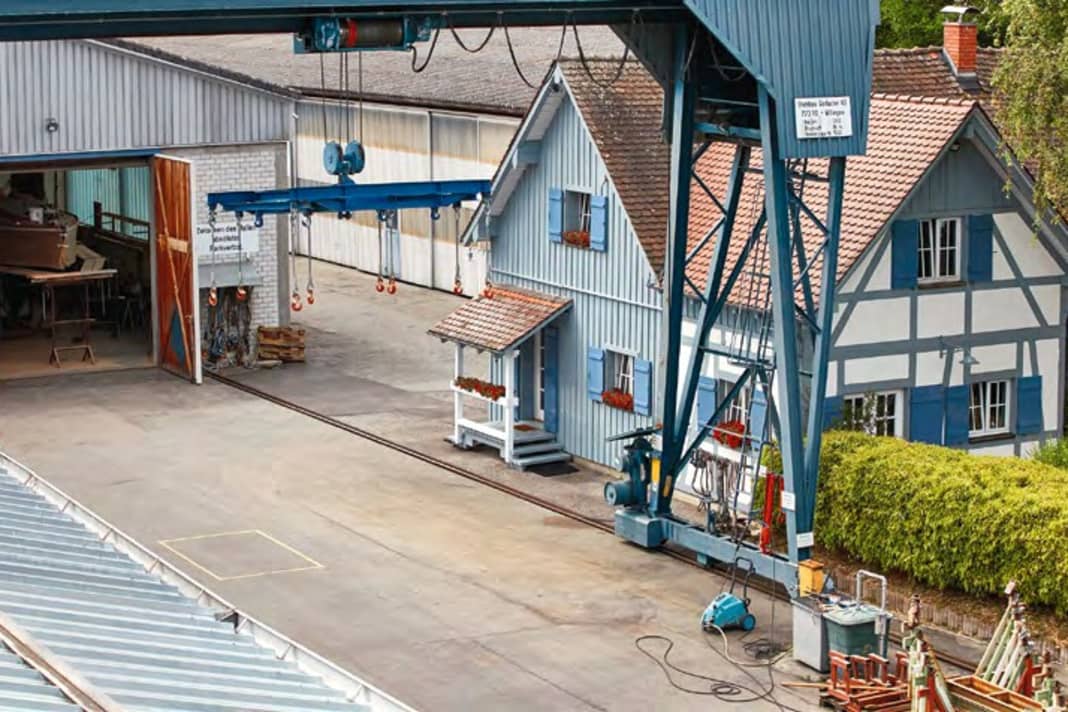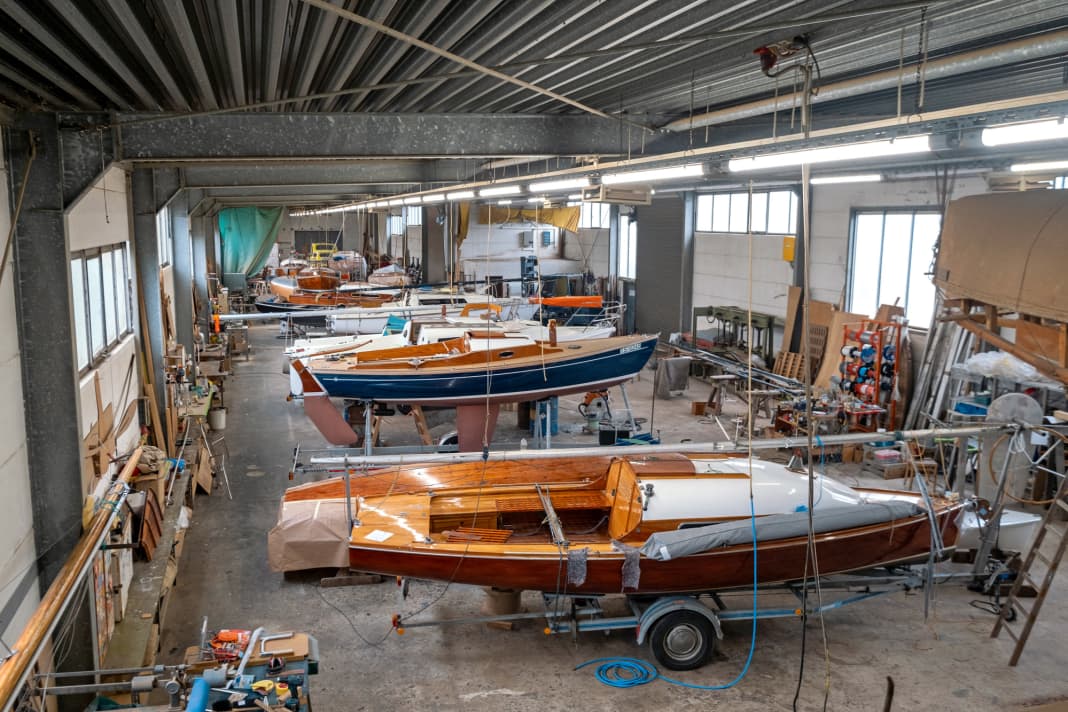





Old traditional companies have become rare, especially in boatbuilding. Only a handful of the legendary shipyards from the heyday of wooden boatbuilding have survived. Even fewer have remained true to their line over time. While Abeking & Rasmussen, for example, is still building boats after 115 years, nothing remains of the original dinghies and centreboards. Today, A&R builds large luxury yachts.
Another shipyard, on the other hand, which can certainly be mentioned in the same breath as A&R and is also often abbreviated with two letters, has hardly changed in 125 years. At F&D, Fricke & Dannhus, from Hüde am Dümmer, the same type of ships are now being built in the fifth generation as in the early years. With passion. With enthusiasm. A family business that has evolved, but at the same time has remained true to itself. Reason enough for a visit to the shipyard.
From the outside, the "sacred halls" appear completely inconspicuous, exuding the charm of the late seventies and not at all matching the fine mahogany boats that are manufactured here. A few such hulls stand behind a glass façade. An old centreboard from Abeking & Rasmussen, for example, which has just been completely overhauled. Next to it is a modern 15 dinghy cruiser in regatta design. Fricke & Dannhus made a name for itself decades ago with boats like these and celebrated success on the regatta courses. A moulded bathtub stands somewhat forlornly between the boats. "That was once an idea," explains Jens Dannhus, "we wanted to try something different." The 52-year-old joined the company in 1990 and has realised many ideas and boatbuilding projects over the past 33 years. But he has also built bathtubs.
Boatbuilding began at Fricke & Dannhus as a "crazy idea"
The members of the Fricke & Dannhus families have always been inventive. "It all started with Heinrich Fricke," says Dannhus. He founded the company as a joinery 125 years ago. "He built everything from staircases to coffins," recalls the boss. "And since then, everyone after him has been working with wood." The leap to ships was only made a generation later. Georg Fricke was an artistically talented and creative craftsman - and because the Dümmer was on his doorstep, he began to build a boat. "His father Heinrich thought it was a crazy idea, as fathers sometimes do," reports Dannhus, "but Georg was not dissuaded. We've been building boats ever since."
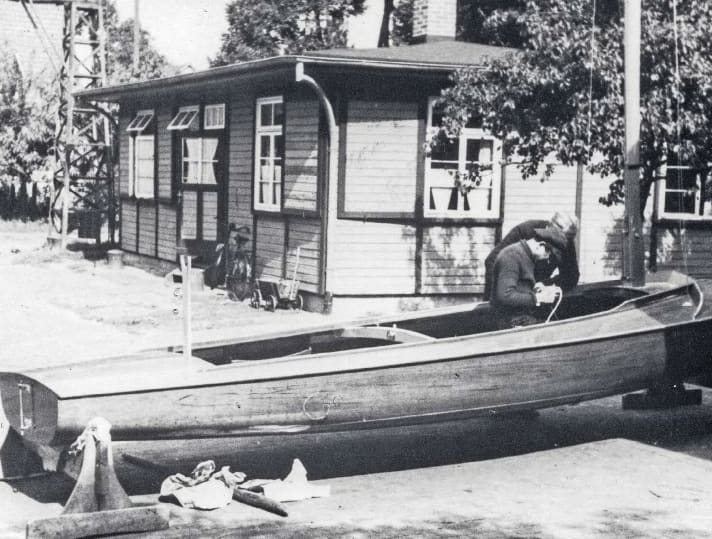
The small shipyard has launched a total of 2,500 boats over the years. And not just out of a passion for craftsmanship, but because the family themselves enjoy sailing successfully in their 15 dinghy cruisers. The wall to the offices on the ground floor is densely hung with DSV badges. "From my father," explains Jens Dannhus, "the fourth generation. He was German champion and European champion ten times." He adds somewhat meekly: "I was only German champion twice."
It looks gloomy in the showroom and also a little bleak, which is mainly due to the rainy weather. It is winter. Not a season for sailors, but high season for boat builders. "How shall we start, with a tour of the boatyard?" asks Jens Dannhus. Nobody would want to miss out on that. Even more so in such a traditional company. "Come along then," he nods towards the steel door behind the offices and pushes it open with a flourish. It's bright behind it. And warm. We have arrived in the heart of the shipyard, the work halls. The history of the shipyard is alive here. Sanding, hammering, planing and drilling is going on everywhere.
"Always a boat made of wood!"
In the workshop, there are now a good 15 boats next to each other at all times during the winter. There are two wooden dinghy cruisers, older hulls, in front of the door. One is keel up because repairs are needed to the underwater hull. The moulds of the GRP version hover above it under the ceiling like an ominous threat. Fricke & Dannhus has also been building GRP hulls with wooden superstructures for many decades. The future? Not at all! "When customers sometimes ask which is better, GRP or wood, I hardly understand the question. Always a wooden boat!" Not only for reasons of sustainability, "moulded boats are simply built to last: high-strength, lightweight and particularly durable."
The Jollis are followed by an HD20 and an HD24, the reinterpretation of the popular Hansa dinghy, which F&D has built several hundred times since the 1980s. In addition, there are three GRP ships. The bow of a Neptun 22 is currently being repaired. "We also do this kind of work. There are many sailors here on the Dümmer who bring their boats to us in winter." Jammed centreboards are a constant problem. "We also do small jobs, such as fitting a new mast on an Opti or a new rudder blade for a Pirate."
The line in the hall continues: Hansa dinghies, a dinghy cruiser without a cabin, a barge from Teufelsmoor, then another dinghy. The list of tasks is just as varied: laying a new deck, replacing a bulkhead, replacing frames. "Many customers bring the boats into winter storage and hand in a list of repairs at the same time," says Dannhus. At the far end of the hall is a large table on which components are moulded. At the moment, the mould of a dinghy cruiser cabin superstructure is on it.
Everything is handmade at Fricke & Dannhus
"It's a great technique," says Dannhus, sorting the veneer strips, "it's all put together and soaked in resin, then a lorry tarpaulin is placed over it, a vacuum is created and everything pulls itself into shape. Completely stress-free components." A man who enjoys his craft every day. Even after so many decades.
Everything we do is handmade. No mass production from the milling machine, but every component measured and built by hand"
"We still do everything by hand. That was always important to me. No mass production from the CNC milling machine, but every component is measured and built by hand," says Dannhus. The company still does not have its own CNC milling machine. "But we do have access to a milling machine. For components such as heavily profiled rudder blades, we use it of course," he says. Everything else is made by hand. The company even manufactures brass fittings itself. "It's a bit more expensive than at other shipyards, but they're all handmade and unique." A quality that has characterised the company for generations.
The heating is humming in the hall. It has to be, because paints and resins cannot be processed in a cold environment. In the neighbouring hall, on the other hand, it is freezing cold. One of many winter warehouses. Not just for boats. Hull and frame moulds as well as complete deck moulds for dozens of boats are also stored here. "Before our anniversary celebrations, we even had a real clear-out here and threw away quite a few moulds," admits Dannhus, "for example a mould for an O dinghy that I've been moving from one corner to another for 25 years." Now there is more space for winter storage boats.
Enough teak and mahogany for the next few years
There is plenty of wood stored at the front of the halls for the coming years. "We've bought quite a lot of teak and mahogany in recent years and we'll have enough for a while yet," says the shipyard manager, "and it may sound silly, but you don't need that much wood for wooden boats these days. We mainly use veneers, so there's hardly any waste." The neighbouring hall has just been built - and is already full to the brim. "150 boats have to go somewhere," Dannhus explains the large construction project. "But the new hall was also an important sign for our employees," he says, "that we are investing in the future and moving forward."
Twelve boatbuilders are employed, including eight journeymen and four trainees. "Quite a young workforce, all of whom we have trained." There is zero staff turnover. "When I retire, my son Jannik wants to carry on here and run the business for a few more milestone birthdays," says the senior full of confidence.
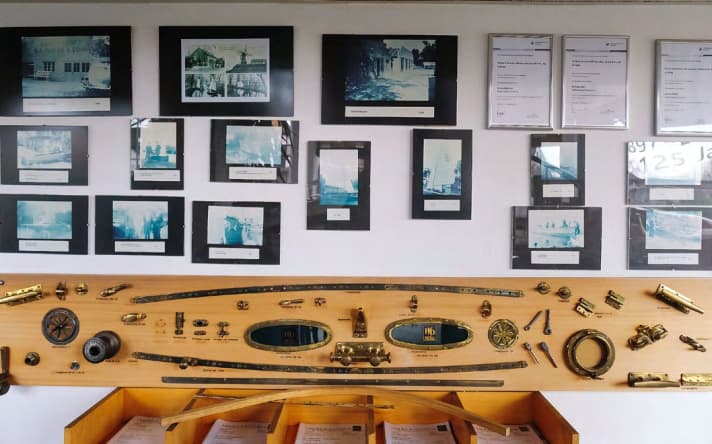
But he's not even thinking about quitting yet. Just like his father Heinrich. He used to draw most of the dinghy cruisers himself and has now officially been retired for a long time, but you can still often find him in the workshop with a paintbrush or a saw. "Honestly, we still need him. He is now 75 years old and a boat builder of the old school," says Dannhus. Especially when it comes to historic boats, his father always knows what to do.
Fricke & Dannhus can do anything with experience
"The other day, three of us were standing in front of a disassembled H-boat and wondering how we were going to get it back together," laughs Dannhus. Wooden boats are versatile, which is why the job is still so exciting for him. "Even after 125 years, we regularly realise that we've never done anything like this before," he says. "But with our experience in solving challenging tasks, we get everything done in the end."
In the end, the entire shipyard team was eager to see whether the ship would float in the waterline.
Things get quite extreme with new builds such as the Pomeranian Flounder, which the company built ten years ago as a one-off for a catboat enthusiast. "Every day of construction was a challenge. Because the boat was built with great attention to detail. From the carved key fob to the original Delft tiles on the wall - every detail had to be conceived, planned and manufactured," says Dannhus. In the end, the entire shipyard team was eager to see whether the ship would float in the waterline. And it did. Of course it did. He still counts the boat as one of his most exciting projects. And the owner still has it transported back to Hüde for winter storage every year.
Fricke & Dannhus fulfils owners' ideas and wishes
The route from there back to the main hall leads past an HD24, which stands between the halls with its sails set. "The owner has to lower the mast every time he goes to his berth because he has to pass under a six metre low bridge," explains Dannhus, "so we have now built him a gaff rig so that the mast can stay up."
He also remembers other projects: "We once had a customer who had bought an old Neptun 22 for 6,000 euros and now wanted to have it completely overhauled for 40,000 euros." There are always customers who have a dream of a boat. "Then it's very fulfilling to accompany them on their journey."
Although Fricke & Dannhus has a portfolio of boat models, the company is open to the ideas and wishes of every owner. "Because we don't mass produce, we are very flexible," says Dannhus. "If someone wants their windows a little shorter or longer, that's the least of the challenges."
The old shipyard hall would make an ideal boatbuilding museum
Customer satisfaction and loyalty is important for a long-established family business. It is therefore not surprising that many sailors bring their boats to the shipyard for winter storage. But space would be too tight at the shipyard site in Hüde alone. A short drive away in Lembruch is still the former site of the shipyard, which was abandoned in 1980. "I'd love to open a museum here one day," admits Dannhus, "because time has stood still here."
The shipyard manager has sold a few machines in recent years to make room for more boats in winter storage. But an old bandsaw, a mast bench and a drying bench heated with coal tell stories of days gone by. In the corner are the frames of a pirate dinghy. "Actually, I'm rarely here. At most in the old warehouse when we need parts for a refit," says Dannhus. Galvanised cleats, lug fittings, hinges, boom and rudder fittings are stored here on two long shelves. Untouched for decades and covered in a layer of dust. "You can't look closely into the corners here," says Dannhus, "but there are some great things here. We then install them directly or use them as samples to recreate something." A goldmine for anyone who wants to restore a boat.
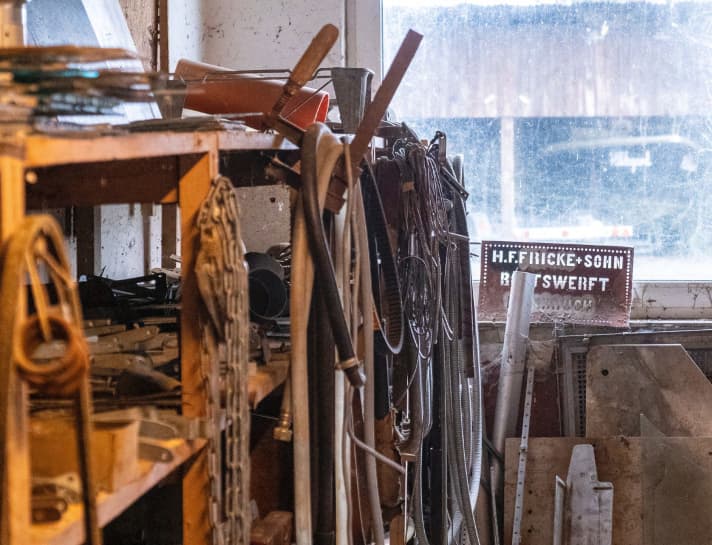
From the outside, the old company looks small, but in the backyard, hall after hall is lined up. All full of boats. "It takes good planning to get to the boats we need to work on in winter." In addition to the old shipyard hall, the Dannhus family owns a shop where everything from oilskins and dinghy parts to ropes and fenders can be found. "We always have enough in stock to fully equip a dinghy cruiser," says Dannhus. The shop is run by the family. Dannhus' wife and mother stand behind the counter. "The boatyard used to be a purely winter seasonal business. The shop carried us through the summer when there was nothing going on in the shipyard. Today, we're busy all year round."
Fricke & Dannhus has an excellent reputation, especially around Berlin
So much so, in fact, that Dannhus initially has to put some customers off. "The other day, someone called to say that he would be bringing his dinghy cruiser in for restoration next week," he says. Completely impossible before May or June. "That's what we've learnt over the years: not to take on more orders than we can handle," he says. Quality and manual labour also take time.
F&D's customers agree that both are worth the wait. The reputation that the company has earned is no accident. "Our boat builders enjoy that too," says Dannhus. Although the shipyard is located in Hüde am Dümmer, the appreciation of their craftsmanship is greatest in the waters of Berlin, where many of their dinghy cruisers are at home. "'Are you from Fricke & Dannhus?', our guys are sometimes asked, with a certain sense of awe," reports the shipyard boss.
"When you've worked here all your life, you don't really notice it," he says, "but when you're surrounded by wooden boat enthusiasts, you realise that we've obviously done a lot of things right in 125 years."
More information and contact details can be found at fricke-dannhus.de
The oldest still existing shipyards
Few traditional companies in Germany can boast such a long history. Four examples in our gallery:
